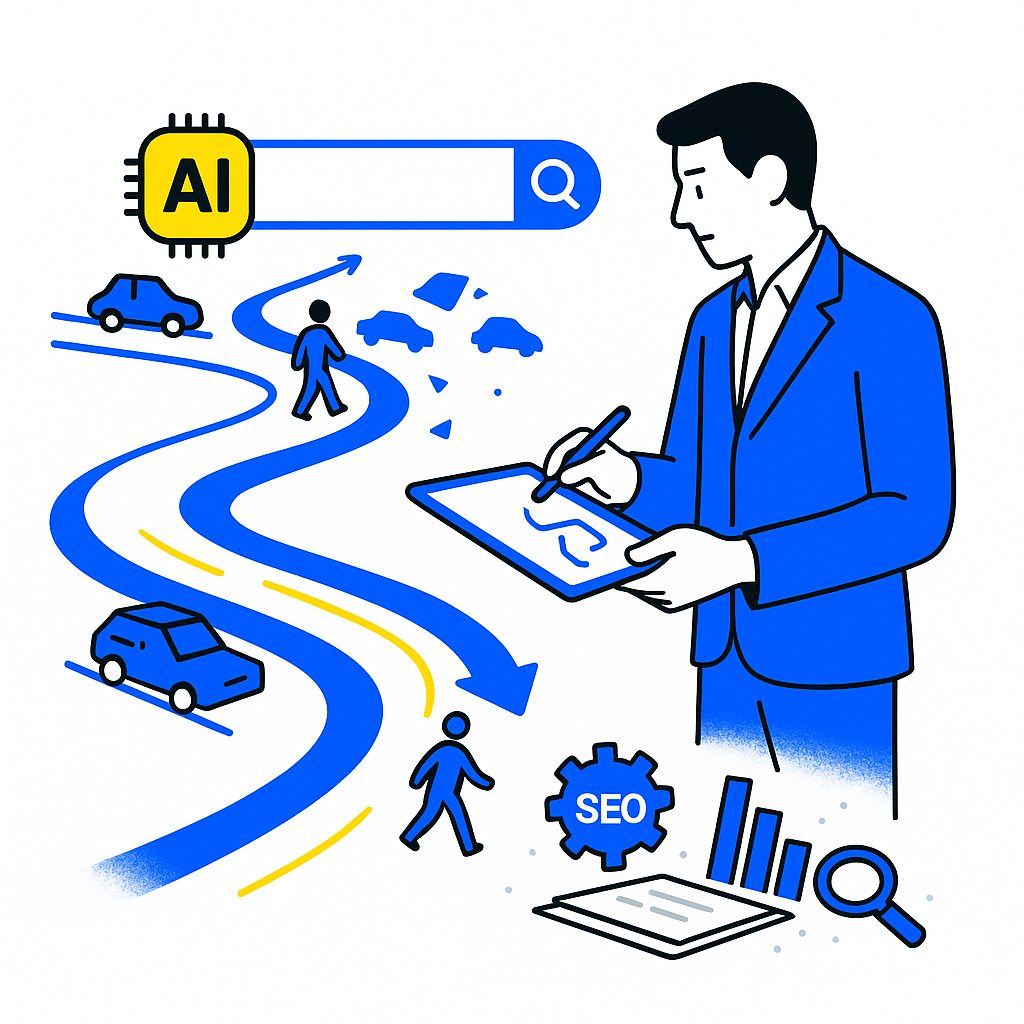Table of Contents
Why Your Traffic Just Fell Off a Cliff
How AI Is Changing the Game for Traffic Acquisition
What’s Actually Disrupted - and What Isn’t
What Winning Teams Are Doing Differently
1. “Brand Building” Means Owning a Real Conversation
2. Own the Audience, Not the Visit
4. Prioritize Experiments, Not Just Output
5. Your Product Needs “Referability”
The Old Playbook vs. What Works Now
How This Is Showing Up with Leaders and Teams I Coach
So, What Should You Actually Do Next?
Audit Your Traffic and Discovery
Tighten Your Positioning and Proof
Invest in Brand-Led Content and Community
Why Your Traffic Just Fell Off a Cliff
This conversation sound somewhat familiar? “Our Google traffic is down 40%. Leads fell off a cliff.” “Organic isn’t working. Paid CAC is through the roof!” “Did you see this? Google’s AI thing just ate our top spot.” "Is it a blip, or are we toast?
It’s not a blip. This is a before-and-after moment for everyone who depends on digital traffic. From marketplaces launching new verticals, to SaaS teams living off pipeline, and digital content shops - all are getting sideswiped by the AI search shift. This isn’t the same old “Google changed the algorithm” scare. This is deeper.
But I’m not interested in handwringing. I care about what to do when your old playbooks die. So let’s break down what’s changing, where the new leverage points are, and how the sharpest tech leaders are already adapting.
How AI Is Changing the Game for Traffic Acquisition
The old internet was simple: Someone Googles your problem, clicks, lands on your site, you wow them, convert, repeat. You built your growth engine around mastering keywords, technical SEO, and publishing content that’d win search intent. That engine built a ton of SaaS and marketplace businesses.
Now, two things are happening fast:
1. Search Looks Different.
Google’s AI-generated answers and Bing’s chat-based search are putting your answers - and your competitors’ - up above the traditional ten blue links. Users get their answer right there, in a way that doesn’t require a click. For a lot of queries, “zero-click search” isn’t hype, it’s reality.
2. Discovery Is Fragmented.
People are finding products through AI chat, TikTok, YouTube Shorts, referral groups, ChatGPT plug-ins, and voice. The “site visit” isn’t the default anymore. Even B2B buyers drop into a Slack channel to get recommendations before touching your site.
Result: The traffic graph starts looking like a game of Whac-A-Mole. Fewer people on your site, more random, harder-to-track touchpoints. Your funnel is leaking everywhere.
Ready to drive more growth & achieve bigger impact?
Leverage my 25+ years of successes and failures to unlock your growth and achieve results you never thought possible.
Get StartedWhat’s Actually Disrupted - and What Isn’t
Before you start overhauling everything, take a breath. Not everything is broken - yet. Here’s what’s really being disrupted:
A. SEO-Dependent Acquisition
If you got 60% of leads from “content marketing” SEO, you’re feeling it. AI results push your hard-won content out of the spotlight - or summarize it for users who never click. I’ve watched SaaS teams see 30 - 50% drops overnight. Marketplaces relying on comparison pages? Same story.
B. “Owned” Audiences Get Pricier
Retargeting, email marketing, and direct engagement used to be cheap. Now everyone’s fighting over smaller pools of owned traffic. Expect higher CAC - especially for paid channels like branded search and retargeting.
C. Brand Recognition, Not Just Keywords
Here’s the plot twist: Businesses with strong brands or loyal communities fare way better. AI pulls from “authoritative sources” - which means the big names or sites with lots of signal and network effect dominate. Upstart SaaS or marketplace offering? You feel invisible.
Not Disrupted (Yet):
- High-intent, low-funnel paid tactics are less affected.
- Niche word-of-mouth (especially in private groups or industry Slack/Discords).
- Email, if you treat it as a real channel - not just another blast.
You can’t “optimize around” this by just refreshing your SEO cheat sheet. AI is rewriting the source code of how people find, trust, and buy from you.
What Winning Teams Are Doing Differently
I work with founders, CPOs, and VP Product across SaaS and marketplace companies. The ones handling this best share a few common moves. None involve wishful thinking or chasing shiny objects.
1. “Brand Building” Means Owning a Real Conversation
In AI-driven results, Google and Bing pull answers from voices they trust. That doesn’t happen by keyword stuffing - it comes from having an actual presence and reputation in your niche.
- Get specific. Host webinars with people your buyers respect. Get staff featured on relevant podcasts and panels.
- Encourage employees to post - publicly and in niche communities.
- Be helpful in high-signal forums (yes, even Reddit).
If you want to see this in action, check out how B2B SaaS founders are building trust and gathering feedback fast. It’s not about volume - it’s about authority.
2. Own the Audience, Not the Visit
AI platforms can summarize everyone’s website. They can’t summarize your relationship with customers.
- Launch a private Slack or Discord.
- Run a “swipe file” style newsletter, where your best insights drop first (not recycled).
- Host invite-only roundtables.
The winners are using a “hub and spoke” model: the website is just one endpoint; the email list, Slack, and community are where you own the reach and the conversion.
3. Diversify Discovery
Where do your customers actually hang out? It’s probably not your website. They’re sharing war stories on LinkedIn, comparing notes on WhatsApp, or watching five-minute explainers on YouTube Shorts.
- Stop treating “social” as one channel. Different personas, different touchpoints.
- Try micro-content experiments: 90-second video demos, Twitter threads, or live demos on LinkedIn.
If you want proof it pays off, check this case study on unlocking marketplace growth strategies by adding low-friction discovery hooks.
Ready to drive more growth & achieve bigger impact?
Leverage my 25+ years of successes and failures to unlock your growth and achieve results you never thought possible.
Get Started4. Prioritize Experiments, Not Just Output
Old SEO was about output (number of posts, keywords ranked). Now, it’s about feedback loops.
- Run fast experiments: repurpose a blog post into a YouTube Short, see which platform brings in the most demo requests.
- Ask customers where they first heard of you - literally run a “how’d you find us?” survey in-product.
Pair this with actual iteration, not naval-gazing.
5. Your Product Needs “Referability”
When so much traffic comes through AI summaries, social snippets, or secondhand recommendations, people need a simple, sticky way to talk about you.
- Tighten your positioning. Can your value prop fit in one sentence?
- Make a “comeback moment” - like a game-changing onboarding ‘aha’ or a tool people want to screenshot.
- Double down on adjunct products: calculators, checklists, templates, free tools.
This is how teams go from being omitted by AI to showing up everywhere customers hang out.
The Old Playbook vs. What Works Now
|
Playbook |
The Old Way |
The New Way |
What to Watch Out For |
|---|---|---|---|
|
SEO |
Long-form posts, keyword targeting |
Short bursts, authority sites, cited answers |
“Zero-click” search |
|
Brand |
Logo, tagline, some press |
Leaders front and center, founder-driven |
Quiet brands get ignored |
|
Audience |
Email list, retarget site visitors |
Slack/Discord, newsletters, micro-communities |
Fragmented, hard to attribute |
|
Social |
Cross-posting, automated scheduled posts |
Persona-led, platform-native, conversational |
Channel fatigue |
|
Experimenting |
Quarterly calendar, set-it-and-forget-it |
Weekly feedback loops, channel tests |
Analysis paralysis |
|
Product Value |
Features list, case studies |
“Conversational” positioning, product-led demos |
Referability over complexity |
Ready to drive more growth & achieve bigger impact?
Leverage my 25+ years of successes and failures to unlock your growth and achieve results you never thought possible.
Get StartedHow This Is Showing Up with Leaders and Teams I Coach
Let’s be real: This change is triggering anxiety. People feel their hard-won growth evaporate overnight. But here’s the thing - I see plenty of opportunity for the teams willing to change habits, not just strategies.
At one Boston SaaS company I coached, their “SEO engine” was so tuned-in, the CMO could practically forecast leads by the week. Then AI answers rolled out… and traffic dropped 50%. Instead of doubling down on old tactics, they re-routed. Launched a Slack channel for customers. Brought product leaders onto industry webinars. Started surveying every closed/won deal with a simple, direct question: “How did you really find us?” Within a quarter, the traffic was flatter - but pipeline and signups rebounded. Leads didn’t have to come from Google. They started coming from humans.
This isn’t just a “marketing problem.” R&D teams had to build onboarding workflows that made sharing easy, and ship meaningful free tools. Sales leaders rewrote talk tracks to emphasize authority and story, not just feature bullet points.
At another marketplace, the magic was in shifting the focus from “publishing more pages” to “building a playground.” They launched interactive guides, quizzes, and bite-sized content designed to get shared (and picked up) by AI answer bots, and by users in their own circles.
So, What Should You Actually Do Next?
Look, you can’t insulate yourself from every wild curveball AI throws at your acquisition engines. But you can adapt much faster than your competitors if you move now instead of hoping this all blows over.
Here are some focused steps:
Audit Your Traffic and Discovery
- Quit obsessing over “organic search” alone. Break down your inbound by how people really found you: social, DMs, AI chat referrals, email forwards, review sites.
- Run a fast diagnostic: where are drop-offs the biggest? Where are new, surprising sources of acquisition coming from?
Tighten Your Positioning and Proof
- Simplify your message so AI/helpful humans alike can summarize it.
- Curate testimonials, reviews, and product success stories - these get cited and picked up by AI, not just humans.
Invest in Brand-Led Content and Community
- Get your CEO or founder to post, record, show up.
- Seed and nurture a micro-community (LinkedIn group, Slack, etc.), not just a “newsletter for everyone.”
- Find the specific nooks where your users hang out, and participate - not just broadcast.
You’ll have to treat content as supply and conversation, not just as a search asset. If you’re in a marketplace model, work on supply and demand org structures that let you invest in both discovery and stickiness, not only pure reach.
Build Feedback Loops, Not Just Output
Pair every piece of content or experiment with a way to measure whether it’s working. Run monthly “attribution retro” meetings with marketing, product, and sales - don’t silo this change.
Here’s an example from my own work: A SaaS founder releasing a new feature now posts a live demo on LinkedIn, runs a Zoom AMA, and ships a walkthrough on YouTube Shorts - all in a week. They don’t care which tactic “wins.” They care about learning, and they recycle what works - fast.
Ready to drive more growth & achieve bigger impact?
Leverage my 25+ years of successes and failures to unlock your growth and achieve results you never thought possible.
Get StartedReflection: Fewer Shortcuts, More Conversations
This AI-driven traffic shakeup means fewer shortcuts and more conversations. If you’re waiting for a new “growth hack,” you’ll wait forever. But if you’re willing to actually talk to your market, show up as a real person or brand, and build mini-movements - ironically, you get picked up by AI and discovered more places, too.
It’s uncomfortable, yes. But every growth playbook you want - from SEO, to email, to social, to product virality - is coming down to the same root: Be talked about, not just searched for.
So take inventory. Talk to your customers. Experiment in public. And when your team panics about the next algo change, you’ll already be three moves ahead - owning real momentum, not just looking for another hack.
Ready to stop reacting and start leading? Let’s get started.
Ready to drive more growth & achieve bigger impact?
Leverage my 25+ years of successes and failures to unlock your growth and achieve results you never thought possible.
Get Started

